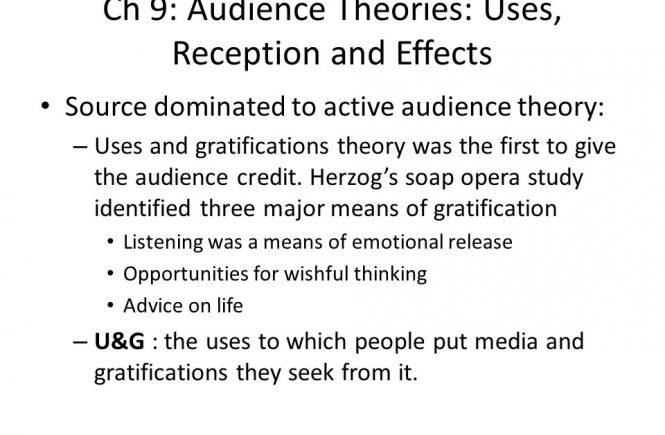Chapter#9: AUDIENCE THEORIES: USES, RECEPTION, AND EFFECTS Audience Theories: From Source-Dominated to Active-Audience Propaganda theories are concerned with audiences. The power of propaganda resides in its ability to quickly reach vast audiences and expose them to the same simple but subversive messages. In these theories, the propagandist dominates the audience and controls the messages that reach it. The focus is on how propagandists are able to manipulate audiences using messages that affect them as the propagandist intends. Most are source-dominated theories. They center their attention primarily on message sources and content, not on the audiences the sources want to influence. As media theories have developed, this focus has gradually shifted. As early as the 1940s, the work of people like Herta Herzog, Paul Lazarsfeld, and Frank Stanton reflected at least the implicit concern for studying an active, gratifications-seeking audience. Lazarsfeld and Stanton (1942) produced a series of books and studies […]
THE RISE OF LIMITED-EFFECTS THEORY
THE RISE OF LIMITED-EFFECTS THEORY Two wars—one imaginary, one real—helped move mass communication theory away from notions of powerful and subversive mass media to a more moderate and benign view. The War of the Worlds researchers, led by Hadley Cantril, were part of a vanguard of social scientists who transformed our view of how media influence society. Within twenty years of Welles’s broadcast, the way many scholars looked at mass media had been radically altered. They no longer feared media as potential instruments of political oppression and manipulation, but instead portrayed mass communication as a relatively benign force with much potential for social good. Researchers gradually came to see media’s power over the public as limited—so limited that no government regulations were deemed necessary to prevent manipulation. limited-effects perspective The guiding idea that media have minimal or limited effects THE DEVELOPMENT OF LIMITED-EFFECTS THEORY The people who developed limited-effects theory […]
